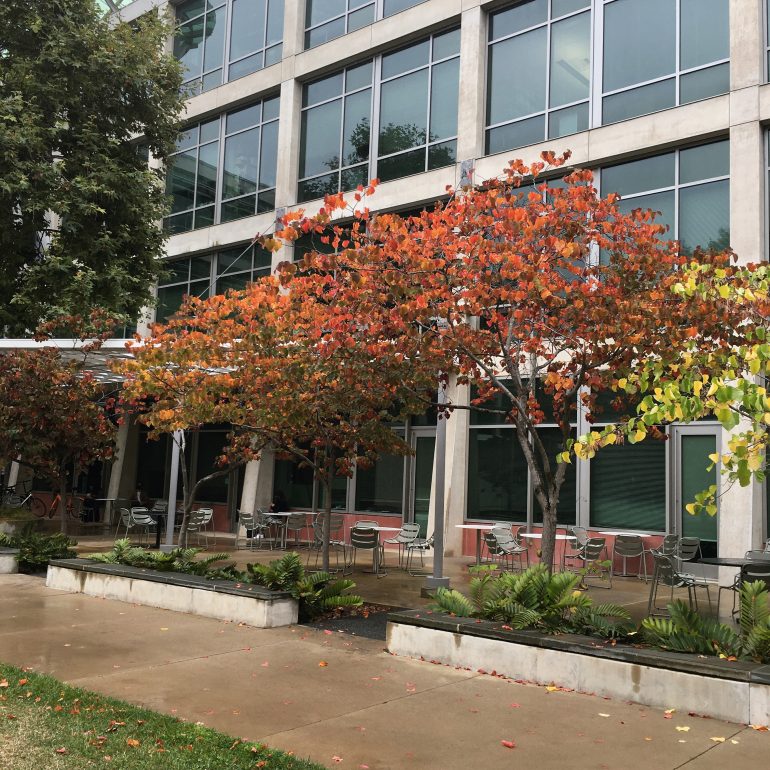After a particularly long day full of dense lectures, looming deadlines, and cloudy skies, I decided to take the long way back to my apartment and explore parts of campus I hadn’t seen before. This eventually led me to a little concrete path behind the Jacobs School of Engineering building. I can’t say exactly what drew me to that spot–all I can say is once I was there, I was immediately drawn in by an unassuming little row of trees, each of which was speckled with the prettiest hues of red, orange, and yellow. Anyone who has lived here in southern California knows that autumn colors are often difficult to find, even in the chillier months of the year when it gets as low as–heaven forbid–56 °F. I’m shivering just thinking about it! In a world of green and concrete, the exhilarating colors of a changing tree make even the gloomiest days feel a bit brighter. Given the COVID catastrophe, students, scientists, and psychologists alike have been keenly interested in what exactly makes humans “feel a bit brighter.” As it turns out, the key might lie in something as ordinary as walking around some fall foliage.
Physically speaking, the human brain is geared for pleasure. Spending time in nature is correlated to an increase in positive psychological emotions as well as in overall love of life and well-being, according to an analysis of 32 studies in a 2015 review. In other words, researchers wanted to know: can we increase our happiness by simply spending a little time in nature? Support for this connection came from three key theories: the Biophilia Hypothesis, Stress-Reduction Theory (SRT), and Attention Restoration Theory (ART).
The Biophilia Hypothesis states that “because humans evolved in natural environments and have lived separately from nature only relatively recently in our evolutionary history, people have an innate need to affiliate with other living things.” The theory explains that because we were born in nature, evolved around nature, and essentially built for nature, it stands to reason that our now city-dwelling bodies feel more positive when re-exposed to nature. Research supports this idea, stating that “brief exposure to natural environments has been found to increase connectedness to nature, which in turn is associated with higher levels of emotional well-being.”
The Stress-Reduction Theory holds a similar notion: “people are less stressed, physiologically, and psychologically, when observing or present in the types of natural environments that provided the resources necessary for survival during our evolutionary history.” Research conducted at Texas A&M and the University of Delaware provides significant empirical data supporting this theory. Subjects were tested, both with real and simulated natural environments: plants, rushing water, scenic landscapes, etc. The results showed that participants’ physical systems (i.e. blood pressure, heart rate, physiological arousal responses) were more relaxed, having less stress and an improved mood.
Finally, we have the Attention Restoration Theory, which looks at the cognitive performance of people in cities versus in nature. Unlike the first two, this theory is less about the presence of a positive effect and more about the absence of negative factors, which produces a consequently positive effect. It is believed that the various visual and auditory signals in cities–traffic, loud noises, fast-paced vehicles, internet and cellular devices, work, people, etc.–can overwhelm and burn out our capacity to be voluntarily attentive. In nature, however, there are less things to distract or stress us and more visuals that fascinate us, “thus allowing for the replenishment and restoration of cognitive resources.” To test this, subjects were exposed to urban or natural environments, then asked to complete various cognitive, attention-based tasks that required direct focus. Both their task performance and their emotional states were evaluated before and after each exposure. Ultimately, the subjects performed better on the attention-tasks and felt happier after being exposed to nature scenes, as they came from a relaxing, arousing psychological environment compared to a highly demanding one.
Ok, so there is evidence that nature can have a positive effect on our mental and physical well-being. What does that specifically have to do with autumn? According to research done by scientists I. Biederman and E. Vessel, the answer may be in the colorful foliage. Areas in our brain are dense with mu-opioid receptors (receptors that receive and process opioids to create pleasurable or pain-relieving effects on the brain and body). The scientists described us as being “infovores,” beings that feed and thrive on the obtaining of new information, new knowledge–whether it is useful for day-to-day life or not. To explore this, they examined the parts of the brain that process information in macaque monkeys, and looked closely at where clusters of mu-opioid receptors were distributed. These areas included the cerebral cortex, the ventral pathways, and the primary visual projection areas. Fascinatingly, they discovered “that the [mu-opioid] receptors are distributed in a gradient that gradually increases in density along the… ventral visual pathway, which is involved in the recognition of an object or a scene.” It turns out, the parts of our brain that process visuals are most stimulated when presented with novel, or colorful visual stimuli (eye-catching pictures, for instance). The scientists tested this by presenting subjects with a series of real-world images (parking lots, lightning storms, trash sites, monkeys, etc). During their experiment, the researchers found a high surge of fMRI activity in the visual processing areas, as predicted. Interestingly, the areas of our brain that process pleasure (those that have dense amounts of opioid receptors) were also highly activated. The newer, more novel, or more colorful the visual stimuli, the more activity in the brain, and consequently, the more pleasure we feel. This is especially useful in areas like Southern California–what feels more novel than changing seasons and beautiful fall foliage amidst the drought and concrete?
Now forget the idea of “novel” information for a second, and let’s look at this another way–through colors. Our eyes take in light through the retina, which is absorbed into photoreceptors in our eye called “rods” and “cones.” The cones contain photopigment molecules that absorb color and turn that energy into electrical signals for our brain to process. Over the years, psychologists have learned a lot about how our brain processes colors and other visual information. In 1878, physiologist E. Hering proposed the opponent-process theory of color vision. It explains that we perceive color through two opposing systems: the blue-yellow mechanism and the red-green mechanism. For example, our eyes can see reddish yellows or yellowish and bluish greens, but we will never see reddish-green or bluish-yellow. These colors oppose each other (meaning that they cancel each other out) and enhance the other. The more our brain perceives “red” color light, the more it prohibits our brain’s “green” signals from firing. This creates a sort of “detector” in our brain to spot color contrasts in the world around us. Some have theorized that this helps mammals spot ripe, red fruit in the wild, helping them survive. A bright red apple in a field of green leaves sticks out like a sore thumb to our brain, causing our cells to fire at their maximum.
The same opponent-process takes over when we walk by a field of green trees and suddenly notice the one starting to change color. In a marketing study that examined the relationship between colors and memory, it was concluded that our eyes naturally gravitate towards warmer, fiery colors (i.e. reds, oranges, and yellows), than to blue and neutral shades. These brighter colors are set apart from the rest of our visual field, making them quite literally “eye-catching.” They interrupt our surrounding environment and cause us to stop in our tracks and stare for a second–which alone can be an act of wellness. “When I work with [anxious] clients… I try to interrupt their stress reactions with positive sensory and kinesthetic experiences,” says Michelle Harris, William James College professor of counseling psychology and art therapy. “When you’re walking and focusing on the changing leaves…you’re cuing your brain to pay attention to something beautiful and enjoy it.” By breaking up our attention with pleasant activities and moments where we simply focus on what’s in front of us, we can get out of our own head, so to speak, and temporarily turn off the fight-or-flight stress we feel. Due to their attention-grabbing nature, the fiery colors of autumn are especially suited for this.
In the life of a college student, there are maybe a thousand things to feel worried or anxious about at any given moment. Midterms, class registration, grades, essays, recreational activities, clubs, Greek life, and at some point, just remembering to eat and sleep–the list is exhaustive. Most of us don’t always have time for a full nap or meditation session. In that case, do what is simple and effective: take a stroll! When you’re heading to your next class or just need some fresh air, take a moment to go leaf-peeping. See if you can find a few trees here and there that aren’t afraid to break the So-Cal quo and let their bright autumn colors blaze!
Sources:
https://www.tandfonline.com/doi/full/10.1080/17439760.2014.994224
https://www.sciencedirect.com/science/article/pii/S0272494405801847
https://www.americanscientist.org/article/perceptual-pleasure-and-the-brain
https://www.ncbi.nlm.nih.gov/pmc/articles/PMC3743993/
https://www.psychologytoday.com/us/blog/minding-the-body/201509/how-autumn-leaves-color-our-inner-lives

